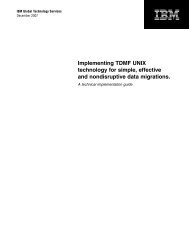Component business models - IBM
Component business models - IBM
Component business models - IBM
Create successful ePaper yourself
Turn your PDF publications into a flip-book with our unique Google optimized e-Paper software.
<strong>IBM</strong> Business Consulting Services<br />
Many firms are in this “strategically partnered” phase<br />
today, and for good reason. Working with specialists<br />
confers many benefits. With their inherent scale<br />
advantages, specialists allow the firms that partner with<br />
them to boost the margins of products and services. And<br />
specialists often bring access to new markets and sales<br />
channels to the deal, making partnerships a good way<br />
for firms to grow revenue through nontraditional sales<br />
channels and to boost growth opportunities.<br />
But there is also a downside. For firms held together<br />
with proprietary architectures and technologies, ad hoc<br />
retooling to support strategic partnerships requires heavy<br />
investment in capital and management time. And often,<br />
the links they establish with partners are also proprietary,<br />
so as the number of partners grows, contracting and<br />
coordination costs tend to creep upward, while strategic<br />
responsiveness declines. So even with strategic partnerships,<br />
the inefficiencies and impediments of proprietary<br />
integration can leave firms vulnerable to upstart peers<br />
designed from the bottom up to take full advantage of the<br />
global connectivity platform.<br />
2<br />
Figure 1. The three phases of external specialization.<br />
Phase 1<br />
Internally integrated<br />
Proprietary standards for manual<br />
and electronic communication<br />
within the enterprise (e.g.,<br />
mainframe)<br />
Ownership of adjacent areas of<br />
the value chain<br />
Emphasis on quality inputs and<br />
distribution<br />
Phase 2<br />
Strategically partnered<br />
Emerging standards for intraenterprise<br />
technology and<br />
communication (e.g., TCP/IP,<br />
Client Server)<br />
Initial specialization within the<br />
value chain<br />
Use of external partners to provide<br />
non-core activities<br />
Divestiture of non-core functional<br />
groups<br />
Phase 3<br />
Industry networked<br />
Open standards based on common<br />
technology and communications<br />
®<br />
protocols (e.g., XML, Linux ,<br />
JBOSS)<br />
Concentration on core activities and<br />
orchestration of networked value<br />
chain<br />
Emergence of ecosystems around<br />
major players<br />
Niche players<br />
1970 1980 1990 2000 2010<br />
Source: <strong>IBM</strong> Institute for Business Value.<br />
To avoid being outclassed by these focused, nimble<br />
peers, smart firms are pushing through to the ultimate<br />
phase of external specialization – the “industry networked”<br />
phase. In this phase, firms focus on their specific areas of<br />
expertise and begin to play as part of coordinated industry<br />
“ecosystems,” or flexible networks driven by collaboration,<br />
universal connectivity and standardized contracting<br />
(based on XML and other technologies that automate the<br />
exchange of information between applications).<br />
Apple Computer’s iPod phenomenon provides one<br />
example of how these industry networks can transform<br />
<strong>business</strong>es – and even create fundamentally new markets<br />
– by providing companies with access to a wide range<br />
of specialized capabilities. By collaborating with external<br />
specialists, Apple was able to take existing, off-the-shelf<br />
technologies – such as portable hard drives, liquid crystal<br />
displays and rechargeable batteries – add Apple styling<br />
and design savvy and sell the new product as part of<br />
an integrated music download service. 1 In a few short<br />
months, external specialization allowed Apple to combine<br />
aspects of consumer electronics, media and information<br />
technology to create something truly new. In the process,

















